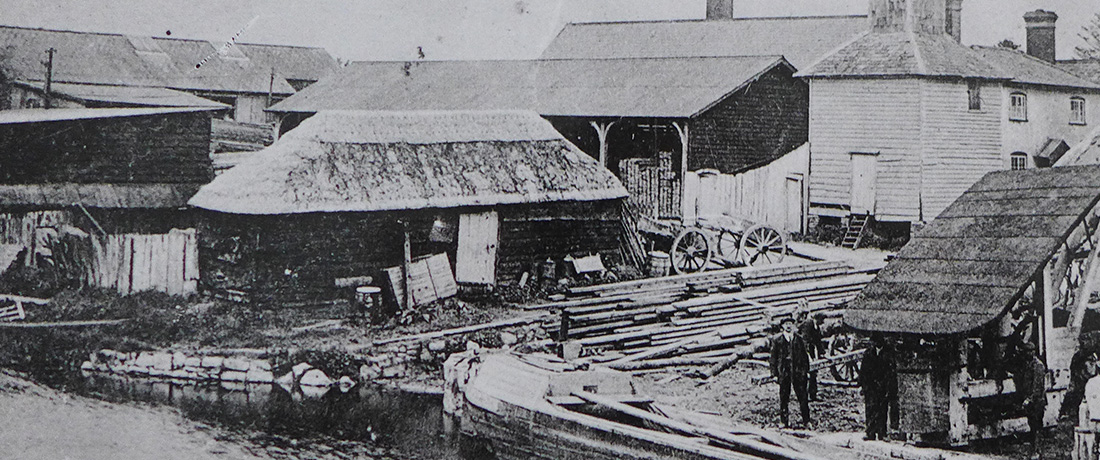Honeystreet Mill – Our story
The first canals in England were dug by the Romans, when they weren’t busy making roads. By the onset of the Industrial Revolution, when it was realised that stuff had to be transported from the ports and factories to London, the canal network really took off. In fact, the UK was the first country to boast a national network of canals.
The Kennet and Avon canal was built by John Hore joining the river Avon and the Thames to provide a waterway from Bristol to London.
The canal arrived in Honeystreet in 1810 prompting our Victorian entrepreneur Samuel Robbins to begin to build his wharf and timber yard.
In 1860 Robbins was joined by his son-in-law Ebenezer Lane and by Henry Pinniger, and so the company Robbins, Lane, & Pinniger (RLP) was born.
Over the years the buildings on the wharf were added to, caught fire, fell down, and were replaced. The iconic chimney was built after one of the fires, to act as the equivalent of an extractor fan removing fumes from the sawmill’s engine house and reducing the fire risk.
Through the high and lows of prosperity, the entrepreneurs dabbled in many enterprises and enjoyed successful trading for almost 90 years.
The mainstay of their business was timber: importing it, drying it, sawing it, selling it, and building barges out of it to transport it. They were market leaders in their barge designs. The Kennet barge and Honeystreet barge were known across the Southern waterways from Wales to London. ‘Diamond’ was one of the last barges built on this site.
‘Unity’ is one of their most famous barges today. This had been specially designed and made by RLP for their own use to maximize load capacity to and from Bristol. It was HUGE: longer than two double decker buses and wider than an army tank. On the Bristol trips Unity was used to bring back timber. On these trips one horse walked to Bristol with Unity, while the other horse took the train. The two horses then pulled the 50 tons of timber (the equivalent weight of 40 Mini Coopers) back to Honeystreet in just three days. The distance was 48 miles and there were 50 locks along the way!
Robbins, Lane & Pinniger also dealt in Welsh slate and fertiliser amongst other things.
These businesses created many jobs and in1896 there were 136 workers on the payroll. RLP were progressive employers and offered a benefits and savings scheme. They also provided sick pay.
In 1949 the business was sold to John Read who continued working the sawmills.
In 1958 Len Neale bought the site for his fabric recycling business. By then the original boat-building shed had fallen down but the new owner, Mr Neale, replaced it with two more and bred a team of 200 ducks in them yearly to combat the canal’s tangles of duckweed.
Mr Neale also restored, maintained, and modernised the site, adding stairs to replace loft ladders for example and buying a canteen building from RAF Alton Barnes which was just next door. Despite the canteen’s relocation, its telltale RAF blue rafters still give away its origin. While valiant efforts to save the site’s clock tower building proved in vain, happily the clock itself was rescued and repaired and is now on display in Crofton Pumping station.
The Present
What to call all these past owners? Wharfingers of course – that’s the name for the boss of the wharf. Today the site’s wharfinger is John Wyles. He has run his narrowboat holiday hire business from here since 2016. He enjoyed learning that RLP ran a boat hire business as well! In fact the more we looked at RLP’s enterprise the more we felt we were following in their footsteps. Our business, The India Shop has been trading here in Honeystreet for the past 15 years. We, like RLP, import recycled wood with our range of Indian furniture, we, like them, are committed to employment rights through fair trade, and we too have diversified by dabbling in chemistry with our new fair-trade bath and body range ‘Honeystreet Handmade’. The final cherry on the cake is this café, which revives RLP’s stipulation that customers should be offered refreshments in one of the boatyard’s buildings. So it seems that history really does repeat itself. As you enjoy your refreshments, imagine this rich history of sawdust, sunshine, and hustle and bustle of
